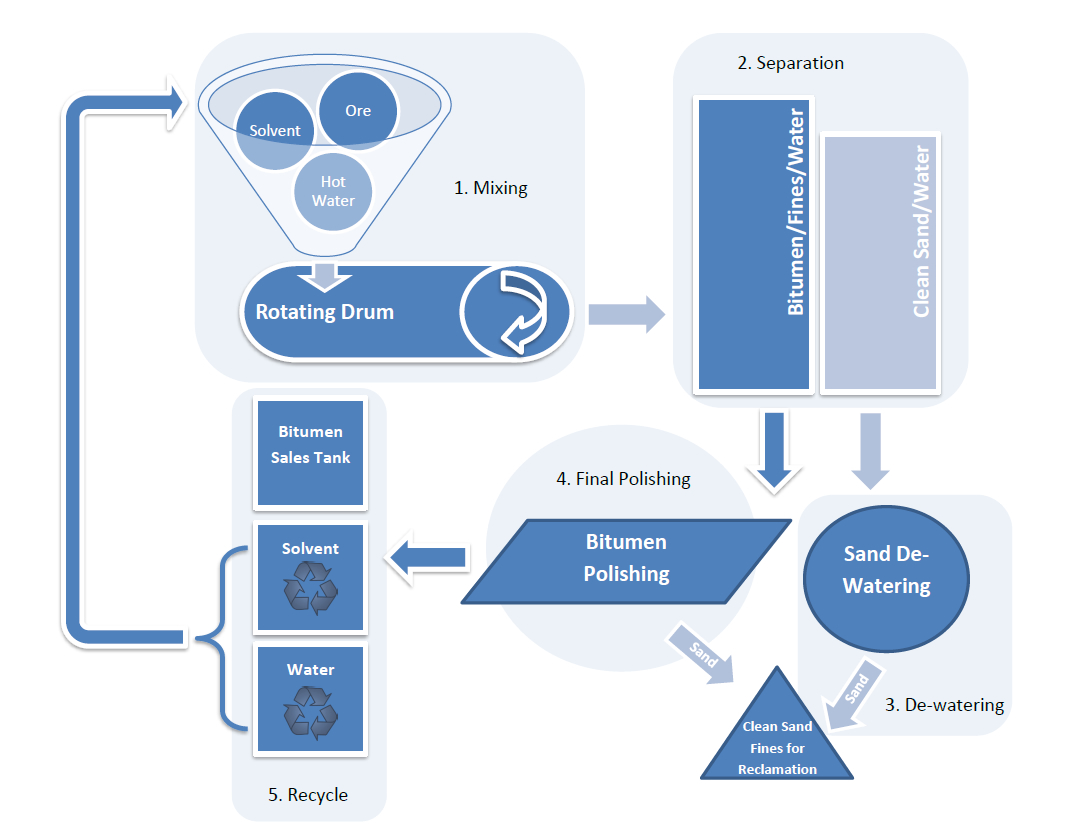US Oil Sands' proprietary extraction process is a breakthrough in oil sands extraction. All commercial mineable oil sands producers use an extraction method called the Clark Hot Water Extraction Process developed in the 1920s by Dr. Karl Clark collaborating with the Alberta Research Council . The process was put into commercial production in 1967 by Great Canadian Oil Sands Limited, now Suncor Energy Inc.
To understand how our proprietary extraction process differs, it is helpful to understand the basics of the Clark Hot Water Extraction Process.
- Surface oil sand is mined and crushed for size reduction
- Hot water at 50-80oC is added to the crushed oil sand to allow the heavy bitumen to become less viscous and separate from the sand
- To expedite the slow separation process, vigorous mechanical mixing takes place together with the use of long hydro-transport lines, resulting in:
- Decreased residence time at the extraction facility allowing increased oil sand throughput.
- Tightly nested suspension of clay, water and bitumen
- Coarse solids sink readily and are removed and used for tailings pond construction
- Bitumen is recovered by applying flotation process wherein air is bubbled into the suspension, the bitumen droplets become attached to air bubbles and float to the top of the vessel allowing most of the bitumen to be recovered as a product called bitumen froth
- After the bitumen froth is deaerated, it is a highly viscous fluid typically consisting of 60% bitumen, 30% water and 10% solids. This mixture is not suitable for pipelining; therefore it must undergo froth treatment
- The bitumen froth is first diluted with a hydrocarbon solvent to reduce the viscosity and density of the oil phase. This accelerates the settling of the impurities by gravity or centrifugation. The bitumen is skimmed off and processed further to reject the entrained solids and water, to meet the requirements of downstream pipelines and refineries
- The rejected solids and water from the froth treatment process, together with all the residual water, solids, added chemicals and unrecovered bitumen are referred to as middlings and are the waste to be disposed of in tailings ponds
- Because the waste stream has economic value as well as a significant environmental impact, producers invest significant capital and operating costs in various technologies to capture as much value from the middlings as possible before discharging to the tailings pond for long-term storage
The Clark Hot Water Extraction Process is an operationally complex and capital intensive process that is over 90 years old and that has been in commercial use for 45 years.
It's Time For A Change... How Do We Differ?
US Oil Sands' proprietary extraction process uniquely engages the use of a biodegradable, non-toxic solvent derived from citrus products. The result is that:
- Only very low mechanical energy is required to mix the oil sands, water and solvent
- Elimination of the activation of the fine clay particles and resultant creation of the emulsion of water, clay and bitumen
- Reduction of suspended clay particles within the process water which eliminates the generation of liquid tailings
- Elimination of middlings. Clean solids, water and bitumen phase separation do not require tailings ponds to settle a middlings phase
All of the capital cost and operating expense associated with creating bitumen froth, froth treatment, middlings treatment and tailings pond management and reclamation is eliminated. The result is a highly capital efficient and operationally simple extraction process.
The process is outlined here:

- Mixing
- Ore from the mine is milled and conditioned, and then mixed in a large rotating drum with hot water and solvent
- This process is low-shear and allows the complete breakdown of the ore into its constituent grains. The mixing of water and bitumen does not form a clay/water/bitumen sludge
- The solvent readily mixes and dissolves into the bitumen, and heat from the water helps to reduce the viscosity of the mixture
- Separation
- The mixture of diluted bitumen, water and solids feeds into primary separation vessels to separate the various phases
- The mixture is separated into:
- Hydrocarbons, water and fine solids
- Clean coarse solids and water
- After less than 30 minutes of process, the two phases are now ready for final polishing to remove the small amounts of mixed components
- Solids Dewatering
- Coarse solids are dewatered using conventional solids dewatering equipment. Free water entrained in the sand is removed so that the sand is damp dry
- The sand is commingled with the fine solids for transport back to the mine and reclamation
- Hydrocarbon Polishing
- The diluted bitumen is processed to sales specifications, which separates the remaining fine solids and water
- The diluted bitumen is then processed through a single-stage distillation process to remove the bio-solvent which is then recycled
- The hot un-diluted bitumen is stored for delivery to refineries
- Fine solids are commingled with the damp sand for transport back to the mine and reclamation
- Recycle
- 98% of the solvent is immediately recycled and reused in the process
- 95% of the water is immediately recycled and reused in the process
